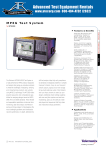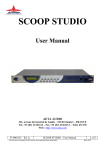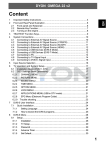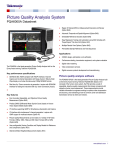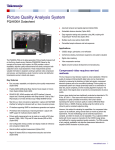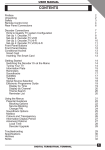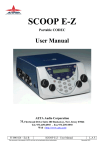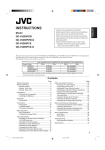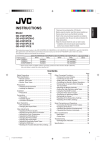Download Tektronix: Products > MPEG Test and Monitoring MTS300
Transcript
M P E G Te s t a n d M o n i t o r i n g MTS300 Features & Benefits Real-time Monitoring and Compliance Testing of MPEG, DVB, ATSC and ISDB Transport Streams for Complete Application Flexibility Status and Error Logging for Capturing Intermittent Problems or Creating Test Records Dolby Digital AC-3 Compliance Testing and AAC Stream Monitoring for Testing Advanced Audio Capabilities Tektronix-exclusive PCR Overall Jitter, Drift and Offset Measurements Allow You to Diagnose the Most Challenging Real-time Performance Problems Detailed Off-line Analysis of Transport Streams, Program Streams and Elementary Streams Available to Fully Verify Design Performance The Tektronix MTS300 MPEG Test System is a high-performance MPEG protocol diagnostic and analysis tool giving you innovative solutions to meet the challenges of designing, verifying and characterizing products and systems using MPEG-2 technology. The MTS300 offers powerful acquisition and computational capabilities for analyzing designs based on MPEG, DVB, ATSC and ISDB standards. These flexible and expandable capabilities include realtime monitoring, data rate analysis and Tektronix-exclusive timing analysis to help diagnose the most challenging problems and characterize real-time performance. In-depth, deferred-time (off-line) analysis helps fully verify compliance to standards and diagnose problems in complex transport streams. Easy-to-use transport stream capture, playout and on-line storage let you build extensive suites of test streams and use these streams to exercise your designs. 1 MPEG Test • www.tektronix.com/video Additional stream editing capability, with error and jitter injection and real-time multiplexing, gives you the ability to create and playout test sequences that fully stress and characterize design parameters. Real-time Monitoring The MTS300 uses intuitive icons and colors to indicate the current status of MTS300 I/O ports and any MPEG transport stream under analysis. A simple, easy-touse display indicates: The current usage and status of the MTS300 I/O ports. You can install up to four I/O ports on an MTS300 The current status of monitored transport streams and the programs within monitored transport streams. Highly visible indicators let you quickly identify the transport stream or program with problems The type of problem detected in a monitored transport stream. Intuitive icons show problems in transport stream protocol, timing errors, or problems in the video or audio elementary streams ASI/M2S, SPI (LVDS), SMPTE310M and DHEI Interfaces Available to Support a Variety of Design Configurations Capture, Playback and On-line Storage of Transport, Program and Elementary Streams Optional Editing Capability Allows You to Create Custom Transport Streams and Inject Errors or Jitter to Fully Stress Your Design Modular Architecture Lets You Purchase the Performance You Desire Today. You Can Easily Upgrade in the Future as Your Needs Change Applications Evaluation and Verification of MPEG, DVB, ATSC and ISDB Designs Design and Verification of Digital Video Set-top Boxes (STBs) Stress and Characterization of Circuits and ICs Developed for Products Using MPEG-2 Compressed Digital Video Technology MPEG Test and Monitoring MTS300 Using this display, you can easily configure and control the product in real-time testing applications, to quickly identify and diagnose problems with designs or to characterize design or system performance. The MTS300 Master Client The MTS300 Master Client application controls real-time testing operations and displays status information organized into three panels. Port Manager Panel. The Port Manager lets you configure and control the MTS300 I/O ports. You can assign an application server to these ports that either monitors or captures the transport stream present at the MTS300 input interface associated with the I/O port, or plays out a transport stream at the MTS300 output interface associated with the I/O port. Different icons represent the different ports and application services. For monitored transport streams, red icons let you immediate identify the transport stream experiencing problems. Services Panel. The Services panel displays the status of each program or service in the monitored transport stream selected in the Port Manager panel. Different icons represent different programs or services. The same red icon indicates a service experiencing problems. 2 MPEG Test • www.tektronix.com/video Details Panel. The Details panel displays the types of problems the MTS300 detected, and changes views depending on whether you select a transport stream or a service within a transport stream: If you select a monitored transport stream icon, the displayed icons represent transport stream error types, e.g., problems in system information tables If you select a service icon, the displayed icons represent service error types, e.g., errors in the video or audio programs In both modes, intuitive icons represent error types: a clock for PCR and PTS/DTS timing errors, a speaker for errors in audio services and a video recorder for errors in video services. Real-time Analysis In addition to being an MPEG-2 protocol monitor, the MTS300 gives you powerful real-time analysis capability to help diagnose difficult real-time performance problems. The MTS300 real-time analysis capabilities include: The evaluations recommended by DVB standard TR 101 290 to verify decodability, quality and reliability Tektronix-exclusive timing analysis, including PCR overall jitter and wander measurements Flexible, intuitive displays of data rates and program allocations Figure 1. Typical 3-panel Master Client screen. This screen displays the error status for the monitored MPEG transport stream and monitored services within the stream. Analysis of Mega-frame Initialization packets used in DVB-T Single Frequency Network applications Real-time analysis of transport streams used in data broadcasting applications based on ISO/IEC 13818-6 (DSM-CC) and EN 301 192 standards Fully selectable monitoring depth, fault criteria, and error reporting and alarms Triggered capture of transport streams for later in-depth analysis Status and error logging MTS300 Expert and Configuration Clients To begin real-time analysis, you select a monitored transport stream or service in the Master Client and launch an MTS300 Expert Client. The Expert Client opens with a display of real-time analysis results on the transport stream. This tight integration lets you quickly detect problems with the Master Client, then open an Expert Client for more in-depth analysis. MPEG Test and Monitoring MTS300 TR 101 290 Measurement Display Figure 3. PCR analysis. Figure 2. Typical Expert Client screen. This screen displays information and analysis results of the monitored MPEG transport stream. The Expert Client “status-at-a-glance” display (Figure 2) lets you quickly determine the overall bandwidth and efficiency of the transport stream under analysis. Dynamic graphic displays show data rates, percentage of use, and global data information on each program, PID, and the overall transport stream. The Hierarchy View displays the structure of the monitored transport stream, and the Report View displays analysis results. The various views in the MTS300 use color to help you easily understand analysis results. Green indicates a passing condition for a particular analysis, red indicates a current failure and orange indicates a failure condition has occurred in the past, but is no longer present. You can view analysis results for the overall stream in the Report View or select a specific PID in the Hierarchy View and display analysis results on only this selected PID. The Expert Client offers two views for displaying the results of TR 101 290 analysis. One view gives you a simple “red light/green light” display of the current status of all Priority #1, #2, and #3 parameters. A separate view gives you more detail on the evaluation results. PCR Timing Analysis You can also launch the MTS300 Configuration Client on a selected transport stream or service. The Configuration Client lets you tailor the real-time analysis to meet your specific needs. You can use default analysis criteria or vary analysis criteria from established values to test the limits of your design. For example, you can establish limits on the repetition rate for system information tables, establish timing relationships between table subsections, and set PCR jitter tolerances. Also, you can use the Configuration Client to control the logging and reporting of analysis results. You can specify errors as critical, major, minor, or warnings. You can limit some analysis, e.g. PCR timing, to look at only specific programs or PIDs. The MTS300 offers real-time display of PCR timing analysis (see Figure 3) using a precision oscillator that timestamps incoming PCR values, enabling Tektronix-exclusive measurements of PCR overall jitter, drift, and frequency offset. You can establish fault criteria based on MPEG, DVB, ATSC, or ISDB standards, or your own test parameters. The MTS300 will compare PCR timing measurements against these fault criteria, using red icons to indicate error conditions and logging errors with time of day and date information. You can display multiple PCR views simultaneously to assist in diagnosing timing problems in multiplexers or encoders. MPEG Test • www.tektronix.com/video 3 MPEG Test and Monitoring MTS300 Figure 4. PID allocation. Figure 5. IP data monitoring. PID Allocation The PID Allocation view (see Figure 4) lets you view all PIDs associated with either PSI/SI/PSIP tables or program elements and monitor their data rates. You can set high and low limits for these data rates and the MTS300 will alert you when the data rate falls outside these limits. This capability is especially important when analyzing the output of a statistical multiplexer in order to identify problems with bandwidth usage. Data Monitoring The MTS300 offers support for developing products and systems for data broadcasting applications. The Expert Client performs IP monitoring with detailed views of ISO/IEC 13818-6 (DSM-CC) and EN 301 192 tables, syntactic analysis of these tables with error reporting, and the ability to monitor the data flow in IP sessions included in MPEG transport streams using Multi-protocol Encapsulation. Figure 5 shows multiple DSM-CC elements along with their IP traffic sessions. 4 MPEG Test • www.tektronix.com/video Figure 6. Data storage/capture configuration. Figure 7. Status and error log. Trigger/Capture Data Logging Intermittent problems are difficult to detect and capture. The MTS300 addresses this problem by incorporating a triggered capture function (see Figure 6) that lets you specify an error or event to be monitored, start the process, and walk away. When the designated error or event occurs, the system automatically captures up to 128 MB of data that you can analyze at a later time. In addition, you can filter the capture to remove selected PIDs from the transport stream. You can also manually trigger a capture from the front panel. With data logging enabled, the MTS300 real-time analyzer will store status and error information on the hard disk in a tab-separated text file (see Figure 7). Using the Configuration Client, you can select the information stored in the log and the size of the log files. Log files close when they reach the specified size, but logging continues until the analysis stops, you disable logging, or the hard disk gets full. MPEG Test and Monitoring MTS300 User Definable Parameters Private Syntax Table Editor Using the Configuration Client, you can define the following analysis parameters: The Private Syntax Table Editor lets you describe the syntax of a private table. You can then use the table for testing the syntax of the incoming transport stream, validating private table information. Hardware – Set the number of synchronization bytes before the system begins testing or determines that synchronization is lost. Set the electrical input and output configuration of the Expert Client Analysis – Select the type of testing to be performed (MPEG, DVB, ATSC, or ISDB). Select individual TR 101 290 tests Advanced Analysis – Select in-depth syntax analysis, including system information table inter-dependencies. Restrict analysis to particular programs or PIDs. Establish timing and rate analysis fault criteria View – Enable event logging. Configure message, hierarchical, and graphics displays Data Storage – Configure trigger event, file name and size, and repetition mode. You can filter the capture to remove selected PIDs from the transport stream Data Logging – Configure the type of information stored in the log files and the size of these files DVB-T for SFN (Single Frequency Network) You can monitor Mega-frame Initialization Packets (MIPs), specified in the DVB TS 101 191 standard, using either the real-time or deferred-time analysis capability of the MTS300. MIPs carry information about the type of transmission that will be used to broadcast the transport stream. It is used to synchronize and configure DVB-T transmitters (SFN adapters) using GPS-based time stamping. Simple Network Management Protocol (SNMP) If you are using the MTS300 Master Client in an operational network environment, you can take advantage of the SNMP agent included in the real-time analysis system to control the MTS300 or capture analysis results from a remote location. Deferred-time Analysis and Custom Transport Stream Creation A collection of optional MTS300 software gives you powerful tools for analyzing MPEG-2 transport streams in detail and for creating your own custom streams to use in functional and stress testing. Option DA – Deferred-time analysis and stream creation: software tools for detailed syntactic and semantic analysis of the transport stream, including T-STD buffer simulation, and for creating custom streams, including error and jitter injection utilities Option ES – MPEG video and audio elementary stream analysis: Software tools for detailed analysis of MPEG video elementary streams, including GOP (Group of Picture) structure and I-frame decoding, and for detailed analysis of MPEG audio elementary streams, including extraction of audio content into .WAV files Option AC3 – Dolby Digital AC-3 analysis: Software for detailed analysis of Dolby Digital AC-3 audio content Option TM – Transmission Multiplexing Configuration Control (TMCC) Combiner: Software for adding TMCC information into transport streams Deferred-time Analysis (Option DA) The MTS300 deferred-time analysis capability features four types of displays or views. Hierarchical – Displays the structure of the transport stream and identifies all of the components Interpreted – Works as a tutorial on the MPEG structure. Double clicking any of the fields in the display produces a definition of that field from the MPEG standard Graphical – Uses graphs to show information about PCR (jitter analysis), MUX allocation (rate analysis), and the PID map (for viewing “burstiness” of data) Numerical – Shows decimal, hex, or binary versions of each display You can perform any of the testing below, based on your specific measurement requirements. Syntax testing of the system information (including PES) for conformance to the ISO/IEC 13818-1 standard Consistency checks between the DVB SI, or ATSC PSIP, system information tables Test PSI/SI/PSIP rates, and both PTS/DTS and PCR timing Semantic value checks Full dynamic testing of the T-STD (Transport stream System Target Decoder) including LTW (Legal Time Window) and buffer smoothing. You also have control of the buffer size in each of the T-STD buffers Mega-frame analysis for SFN MPEG Test • www.tektronix.com/video 5 MPEG Test and Monitoring MTS300 All of these tests can be performed either individually or grouped together for automatic execution. Custom Transport Stream Creation (Option DA) The MTS300 gives you the ability to create custom transport streams with complete control over many of the parameters. Userdefinable parameters include: Timing offsets Figure 8. Custom ATSC transport stream with PSIP tables, high-level MPEG-2 video, and Dolby AC-3 audio. Figure 9. Custom transport stream with Mega-frame. Data rates PES packet size Jitter and channel coding DVB or ISDB SI table information ATSC PSIP table information (terrestrial or cable) New Advanced Multiplexer and DVB/ATSC Table Editor – Multiplexer (Option MTS3FMX) The software can re-multiplex: MPEG-2 Video elementary streams These parameters can be easily modified using the included DVB, ISDB or ATSC Table Editor or Jitter Adder programs. You can generate a “known good” transport stream to test performance of the entire system or an individual component under ideal conditions. Because you have control over the user-definable parameters, you can create a custom transport stream with variations to stress performance at or near operational limits. For example, Figure 8 and Figure 9 show custom transport stream creation. All MTS300 systems include CD-ROMs with elementary streams. The video elementary streams contain both motion sequences and traditional television test patterns. 6 MPEG Test • www.tektronix.com/video MPEG-2 Audio elementary streams Decompose Existing Streams MTS300’s off-line multiplexer accepts any recorded transport stream as an input source. The user can then decompose this transport stream into its component PES. The user can then save resulting PES and ES streams onto disk. AC-3 Audio elementary streams MPEG-2 Video PES (packetized elementary streams) MPEG-2 Audio PES AC-3 Audio PES PIDs from other transport streams Other data – the bit rate must be specified The Solution The multiplexer allows the user to collect together components from streams recorded off hard disk or CD/DVD-ROM, manipulate them in an unlimited manner and then rebuild a fully compliant output stream for whatever use is desired. Along the way, the system’s in-built syntax knowledge of tables and descriptors ensure compliance and high quality output of the final multiplex transport stream. Regroup Them with Stored Streams These PES or elementary video and audio streams can be grouped together into logical groups – “Programs” of video, audio and other associated data (private data, e.g., teletext). The original timing relationships are preserved. These streams and/or other pre-recorded PES or ES streams can then be reassembled together to build up a totally new transport stream as the user desires. Regrouping of elementary streams or programs can be achieved within an existing transport stream, by allowing the individual stream identifiers (PIDs) to be remapped as required. MPEG Test and Monitoring MTS300 repetition rate for each table can be changed, overriding the default value. A conditional warning is generated if an illegal repetition rate is defined. “Expert” and “Standard” Modes Figure 10. MPEG video elementary stream analyzer. “Map, Check and Rebuild Your Own Multiplex” These streams can then be rebuilt into a larger multiplex stream and new system information tables can be customized and added. Powerful syntax auto-check warns the user of mis-mapped, reserved or duplicate PIDs, including the Program Paradigm, by checking and automatically updating PAT, PMT and derivable fields (in its “standard” mode) accordingly, to create a final legal and DVB or ATSC-compliant output stream. MTS300’s multiplexer allows the user to be able to construct a transport stream for any rate equal to or greater than the sum of the individual components to be multiplexed. Another facility offered is the ability for the multiplexer to insert correct PCR values on the PIDs defined by the user. This allows for PCRs to be on a separate PID or embedded on an existing PID. Figure 11 - MPEG audio elementary stream analyzer. Generate Compliant Timing and Output Bit Rates As Required The multiplexer is able to insert the PCRs at the correct repetition rate and also allows the user to specify the PCR repetition rate, if desired. “Create, Add or Modify SI Flexibility” The multiplexer allows all of the standard MPEG/DVB/ATSC system information tables (SI) and descriptors to be edited. The user is permitted to generate illegal conditions that allow stress of decoder or transmission chain equipment to verify its robustness. It is also possible to generate private tables and descriptors. Test Feature – Deliberately Create Illegal Streams The software can be set to generate an optional warning when certain illegal conditions have been generated. This is visible clearly on the user interface. In a similar manner, the multiplexer allows all legal descriptors to be added to each table. The Standard Mode will calculate related fields and table pointers (e.g., checksums) for the user without having to worry, but an Expert Mode is also provided to allow the user to set these to illegal conditions for test conditions as described above. MPEG Audio and Video Stream Analysis (Option ES) The MPEG Video Stream Analyzer (see Figure 10) analyzes MPEG-1 or MPEG-2 video streams at different levels (i.e., MP@ML, MP@HL, 4:2:2). It also analyzes the decoding of I-pictures and provides multiple levels of analysis, including: Video sequence Sequence Pictures Group of pictures Both syntactic and semantic (coherence between all components in the stream) analyses are available. An extraction routine allows the user to select and save either the whole stream or a part of the stream. The MPEG Audio Stream Analyzer (see Figure 11) allows you to analyze and decode MPEG audio layer I and II specification streams at different levels. MPEG Test • www.tektronix.com/video 7 MPEG Test and Monitoring MTS300 Figure 12. Advanced ES Analyzer Motion Vector display. The audio analyzer provides the following levels of analysis. Audio Header (AH) Audio Allocation Table (AAT) Scalefactor Table (SCF) Scalefactor Selection Information (SCFSI) Sample Table (SPL) Ancillary Data (AD) At each of these levels, the software can perform syntactic, semantic and CRC analysis. An extraction routine lets you select and save either the whole stream or a part of the stream. You can save the decoded stream in a .WAV file format and play it back on the MTS300 internal speaker. Figure 13. Enlarged section showing Macroblocks and associated Motion Vectors using Zoom Window. New Advanced Video and Audio Elementary Stream Analysis and Display - ES Analyzer (Option MTS3FIN) This application brings to MTS300 not only the ability to actually view the moving picture from within a PES stream, but also to carry out a whole range of sophisticated new tests on the lower layers of an elementary stream within a transport multiplex. This gives added confidence when analyzing streams because encoder performance can be verified right down to slice and block layer together with motion vectors (see Figures 12 and 13). Display and analysis of GOP, Picture, Slices and Macroblock layer Picture quality analysis including Quantizer Scale distribution, motion vector graphs, macroblock and picture-size plots DCT Analysis and display Teletext analysis (PES and VBI) Closed Caption Analysis to EIA 608, 708, 746 DVB Subtitle analysis and display over picture Analysis of MPEG-2 audio to provide plots of allocation bits, scalefactor grouping and SCFSI against sub bands 8 MPEG Test • www.tektronix.com/video Figure 14 - Advanced ES Analyzer picture player. Audio analysis of MPEG-2 audio to provide plots of allocation bits, scalefactor grouping and SCFSI against sub bands Audio analysis of Dolby Digital (AC-3), AAC, AdiFF and ADTS Regression test report generator The sequence header can be viewed along with the extensions. The picture rate, chroma format and the video type (NTSC, PAL, etc.) appear in the status bar when the sequence headers are displayed. The stream can be run through with the option of analysis of the stream at picture level or at the macroblock level. When analyzing the group of pictures (GOP), it is possible to randomly access any picture from within the group, view the picture type, spectrum and display picture size plots. The user can zoom in on the picture to see details at the slice or macroblock levels or view the encoded picture. Picture player (see Figure 14) can be operated until degradation in quality is seen, the picture paused and the details reviewed down to the macroblock level. An easy mechanism is provided to switch between the picture display and the data analysis windows. MPEG Test and Monitoring MTS300 Figure 15. Carousel Analyzer DDB analysis. Figure 16. Carousel Analyzer DII analysis. Macroblocks can be selected and detailed coding investigated. The picture analysis can be performed with special displays of quantizer scale distribution, slice size distribution, macroblock-size spectrum and motion vector plots. Comprehensive error logging is provided during stream analysis and selectable error filters are available. There is also an automated “regression” test mode that can save data from selected fields to report files for viewing later. Quantizer matrices can be downloaded for any picture, at most four matrices, namely intra-quantizer matrix, non-intra-quantizer matrix, chroma intra-quantizer and chroma non-intra-quantizer matrix. The audio analysis capability includes navigation to any audio frame and viewing its details, header, frame data plots. Audio descriptors are interpreted and displayed in higher level streams and validated against the stream. The picture coding extension is always displayed, while the other picture extensions are displayed on tabbed folders; these are copyright extension, picture display extension (PDE), picture spatial scalable extension (PSSE) and picture temporal scalable extension (PTSE). The B and P frame motion vector displays allow you to select Macroblock Intra, pattern motion backward and forward together with macroblock quantization, quantizer scale DCT type and motion vector format. New Solution for High Performance Data Analysis of MPEG-2, DVB and ARIB Transport Streams – Carousel Analyzer (Option MTS3FDB) In-depth off-line analysis of MPEG-2, DVB and ISDB Transport Streams containing DSMCC data broadcast protocols including IP, Data and Object Carousels lets you fully verify product, system design and performance. Figure 17. Carousel Analyzer Carousel Content Repetition Rate and Bit Rate view. Applications Interactive television Software development MHP set top box design Carousel multiplexing Data broadcasting systems installation and integration Equipment design and verification Stream Analysis DVB data and object carousel analysis BIOP, DSI, DII, DDB and DSM-CC section display and interpretation (see Figures 15 and 16) Bit rate and repetition rate display of blocks, modules, objects, UN messages, SI tables and video/audio PIDs (see Figure 17) Display of MHP AIT table ARIB B15/B24 Data Carousel Analysis MPE analysis including syntax of datagram sections Display of PSI/SI/PSIP tables with Huffman decoding Transport stream packet content PCR timing information Boot Timing statistics and graphs MPEG Test • www.tektronix.com/video 9 MPEG Test and Monitoring MTS300 Figure 20. Stream recorder. Figure 18. Dolby AC-3 analyzer. Figure 19. TMCC combiner wizard. Dolby Digital (AC-3) Analysis (Option AC3) Dolby Digital sound uses Dolby AC-3, a proprietary audio coding technique developed by Dolby Laboratories for efficiently storing and transmitting multiple channels of digital sound. This software analyzes Dolby AC-3 elementary streams, including elementary streams embedded in MPEG-2 transport streams, program streams, or packetized elementary streams (PES). Analysis functions include CRC checking, syntactic analysis, and semantic analysis. You can plot graphs for the following fields to observe trends in these values over different sections of the stream. Dialog normalization Heavy compression Dynamic range 10 MPEG Test • www.tektronix.com/video The interpreted display shows the actual data along with each parameter field-name. Double-clicking the field-name produces a definition of that field as defined by the AC-3 standard. Figure 18 shows the Dolby AC-3 analysis application along with two characteristics views. You can save an AC-3 stream on a frame or time basis. You can also save the decoded AC-3 stream in a .WAV file format and play it back on the MTS300 internal speaker. Transmission and Multiplexing Configuration Control (Option TM) For designers developing products and systems for ISDB applications, this optional software lets you add TMCC data to an existing MPEG transport stream to test this aspect of ISDB transmission systems. Using a Windows “wizard” application (see Figure 19), you can easily create single- and multi-stream MPEG multiplexes for ISDB environments. Transport Stream Recording and Playback The MTS300 comes standard with easy-touse transport stream record and playback capability. An optionally available real-time multiplexer lets you manipulate parameters of the generated stream in real time, giving you the power and flexibility needed to fully exercise product or system designs. Transport Stream Recorder and Player The MTS300 Stream Recorder and Stream Player applications provide the capability to generate and to record transport streams using VTR-like controls. Figure 20 and Figure 21 show the Stream Recorder and Stream Player displays. You can use the rear-panel trigger input to initiate the Stream Recorder. The Stream Recorder can capture up to 27 GB of data, equivalent to 60 minutes of data running at 60 Mbps. MPEG Test and Monitoring MTS300 Characteristics System Characteristics Figure 22. Real-time multiplexer. Figure 21. Stream player. MPEG Monitoring, Analysis and Generation Characteristics – Supports MPEG-2, DVB, ATSC and ISDB protocols. Analyzes transport streams in real-time and reports problems with multiplex format, system information (PSI, SI, and PSIP) tables, and video, audio and data content. Options are available for deferred-time transport stream, MPEG video, MPEG audio, AC-3 audio, Data Broadcast and program stream analyzers. Captures and generates MPEG transport streams in multiple formats. Options are also available for transport stream creation and multiplexing. Real-time Multiplexing (Option OM) I/O for Acquisition and Generation The exclusive OpenMux application (see Figure 22) offers an easy way to multiplex MPEG-2 transport streams in real time. The heart of the application is a transport packet multiplexer task that can quickly process many input streams and output a valid MPEG-2 stream. The input streams can represent a single-program transport stream (SPTS), multi-program transport streams (MPTS), elementary streams, private data, PSI tables, DVB or ISDB SI tables or ATSC PSIP tables. You can install up to four (4) rear-panel I/O interface ports on the MTS300 for external acquisition and generation, choosing any of the following options: ASI (M2S), SPI (LVDS), SMPTE310M, and DHEI (GI-Digicypher). Maximum Data Rate, Stream Recorder or Stream Player Operating – 140 Mbps. Modular System Design Number of Input/Output Interfaces – Up to four input/output interfaces with each interface providing input, output, clock and trigger connectors. The main characteristics of the Real-time Multiplexer option include: Dynamic management of MPEG-2 PSI, DVB SI and ATSC PSIP tables SPTS and MPTS file multiplexing Allocation and dynamic filtering of PIDs The modular architecture of the MTS300 supports future system upgrades. You can purchase the system with only the capabilities you need now and can purchase field upgrades later to expand the capability of your system as your needs change or as new tests and technologies emerge. Maximum Data Rate, Real-time Analysis – 180 Mbps. Minimum Data Rate, Stream Recorder or Stream Player Operating – 1 Mbps. Maximum Aggregate Data Rate, Stream Recorder and Stream Player Operating – 140 Mbps. Available Interfaces – Asynchronous Serial Interface (ASI/M2S), Synchronous Parallel Interface (SPI/LVDS), SMPTE310M Synchronous Serial Interface, DHEI (GI-Digicypher). Stream Recorder Storage Capacity – 27 GB nominal. The MTS300 uses the Windows NT operating system and runs on a high-performance platform for maximum flexibility and upgradeability. Re-stamping of PCRs PMPEG Test • www.tektronix.com/video 11 MPEG Test and Monitoring MTS300 Interface Characteristics Platform Ethernet – 10/100Base-T; RJ-45. COM Port – RS-232. Mouse – PS/2. Keyboard – PS/2. Printer Port – IEEE P1284. SVGA – 15-Pin, High density, D-sub. Graphics – 1024x728, 32 K colors minimum. Real-time Monitoring/Analysis and Stream Player/Recorder Applications ASI/M2S (Option AS) – BNC, Maximum analysis data rate: 180 Mbps. Maximum record/play-out data rate: 140 Mbps. Input Port – Connector: BNC. Input Bit Rate: 270 Mbps ±100 ppm. Transport Stream Data Rate: Maximum analysis rate: 180 Mbps. Maximum record rate: 140 Mbps. Minimum record rate: 1 Mbps. Signal Amplitude: Maximum: 800 mVp-p. Minimum: 200 mVp-p. Termination: 75 Ω nominal. Return Loss: +17 dB minimum, 27 MHz to 270 MHz. Output Port – Connector: BNC. Output Bit Rate: 270 Mbps ±100 ppm. Format: Configurable as ASI Burst, ASI Packet or M2S. Transport Stream Data Rate: Maximum loopthrough output rate: Follows input rate. Maximum play-out rate: 140 Mbps. Minimum play-out rate: 1 Mbps. Signal Amplitude (into 75 Ω load): Maximum: 880 mV. Minimum: 500 mV. Rise and Fall Times: 1.2 ns maximum (20% to 80%). 12 MPEG Test • www.tektronix.com/video External Clock Input Port – Voltage Levels: TTL. Low: <0.8 V. High: >2.0 V. Termination: 50 Ω nominal resistive. External Trigger Input Port – Initiates stream recorder. Voltage Levels: TTL. Low: <0.8 V. High: >2.0 V. Termination: 50 Ω nominal resistive. SPI – LVDS Parallel (Option LV) – D25, Maximum analysis data rate: 180 Mbps. Maximum record/play-out data rate: 140 Mbps. Input Port – Connector: D25. Input Data Rate: Maximum Analysis rate: 180 Mbps. Maximum: 140 Mbps. Minimum: 1 Mbps. Signal Amplitude: LVDS. Termination: 100 Ω resistive nominal, line-to-line. Timing Reference: Rising edge of clock. Clock-to-data Timing: Data must be stable ±5 ns of rising clock edge. Output Port: – Connector: D25. Output Data Rate: Maximum loopthrough output rate: Follows input rate. Maximum: 140 Mbps. Minimum: 1 Mbps. Signal Amplitude (LVDS): Maximum: 454 mVp-p. Minimum: 247 mVp-p. Termination: 100 Ω resistive nominal, line-to-line. Signal Common-mode Range (LVDS): 1.125 V to 1.375 V. External Clock Input Port – Voltage Levels: TTL. Low: <0.8 V. High: >2.0 V. Termination: 50 Ω nominal resistive. Frequency Range: 125 kHz to 17.5 MHz. External Trigger Input Port – Initiates stream recorder. Voltage Levels: TTL. Low: <0.8 V. High: >2.0 V. Termination: 50 Ω nominal resistive. SMPTE310M (Option SS) – D25, Data Rates: 19 Mbps and 38 Mbps. Input Port – Connector: BNC. Input Data Rate: Input Data Rate: 19,392,658.5 ±1,000 b/s or 38,785,307 ±2,000 b/s typical. Data Format: Compliant with SMPTE310M. Packet Length: 188 bytes. Signal Amplitude: Maximum: 880 mVp-p. Minimum: 200 mVp-p. Signal DC Offset: ±0.5 VDC, maximum. Termination: 75 Ω resistive nominal, line-to-line. Return Loss: –17 dB, 100 kHz to 77.6 MHz. Output Port – Connector: BNC. Output Data Rate: Loopthough: Follows input rate. Play-out: 19,392,658.5 ±1 ppm or 38,785,307 ±1 ppm typical. Data Format: Compliant with SMPTE310M. Signal Amplitude: Maximum: 880 mVp-p. Minimum: 720 mVp-p. Signal DC offset: ±0.5 VDC, maximum. Signal Rise and Fall Times: Maximum: 5.0 ns. Minimum: 0.4 ns. Signal Overshoot: 10% of maximum signal amplitude. Output Impedance: 75 Ω resistive nominal, line-to-line. External Clock Input Port – Voltage Levels: TTL. Low: <0.8 V. High: >2.0 V. Termination: 50 Ω nominal resistive. Frequencies: 19,392,658.5 ±1,000 b/s or 38,785,307 ±2,000 b/s typical. MPEG Test and Monitoring MTS300 External Trigger Input Port – Initiates stream recorder. Voltage Levels: TTL. Low: <0.8 V. High: >2.0 V. Termination: 50 Ω nominal resistive. Input Port – Connector: 26-Pin D, HD-22 Series. Input Data Rate: Maximum: 40 Mbps. Minimum: 1 Mbps. Signal Amplitude: ECL. Termination: 120 Ω resistive nominal, line-to-line. Timing Reference: Falling edge of clock. Clock-to-data Timing: Data must be stable ±5 ns of falling clock edge. Output Port – Connector: 26-Pin D, HD-22 Series. Output Data Rate: Maximum: 40 Mbps. Minimum: 1 Mbps. Signal Amplitude: ECL. Termination: 120 Ω resistive nominal, line-to-line. External Trigger Input Port – Initiates stream recorder. Voltage Levels: TTL. Low: <0.8 V. Termination: 50 Ω nominal resistive. DHEI – GI-Digicypher (Option DE) – 26-Pin D, Maximum analysis data rate: 40 Mbps. Maximum record/play-out data rate: 40 Mbps. Platform Characteristics Operating System – Windows NT 4.0, (service pack 5). Disk Space – System: 6 GB. MPEG storage: 27 GB. RAM – 256 MB. CD-ROM Drive – 8X. Power Characteristics Source Voltage – 100 VAC to 240 VACRMS, 47 Hz to 63 Hz. Ordering Information MTS300 Hardware Products Altitude – 2000 meters. Includes: MTS300 platform, real-time analyzer, stream recorder and stream player, software protection key and license sheet, read this first manual (071-0666-xx), user manual (071-0658-xx), technical reference manual (071-0667-xx), stream creation applications manual (071-0778-xx), applications CD-ROM (063-3325-xx), operating system CD-ROM (063-3366-xx).Please specify power plug when ordering. Overvoltage Category – Category II. MTS300 Options Pollution Degree – 2; rated for indoor use only. Interface Options – Each adds two input/output pairs, clock and trigger connections. Customers must select at least one interface option. System maximum capacity is two interfaces, one of which must be ASI/M2S. Opt. AS – ASI/M2S asynchronous serial interface. Opt. DE – DHEI (GI-Digicypher) interface. Opt. LV – SPI (LVDS) synchronous parallel interface. Opt. SS – SMPTE310M (SSI) synchronous serial interface. Power Consumption – 170 W, typical. Environmental and Safety Safety Class – Class 1. Equipment Type – Test and measurement. Temperature – +5 ºC to +40 ºC. Relative Humidity – 80% up to 31 ºC. Low Voltage – Meets EN 61010-1:1993. EC Declaration of Conformity – Meets EN 55103-1/2:1996; Electromagnetic environment E4. Emissions – EN 55022, class A; EN 55103-1, Annexes A, B, and E; IEC 61000-3-2. Immunity – IEC 61000-4-2, -3, -4, -5, -6 and -11; EN 55103-2, Annex A. Australia Declaration of Conformity – Meets AS/NZS 2064. FCC Compliance – Meets FCC CFR Title 47, Part 15, Subpart B, Class A. Physical Characteristics Dimensions Width Height (without feet) Depth Weight Net Rack Space Net cm 43.2 21.6 56.0 kg 17.3 Height 5 rack units in. 17 8.5 22 lb. 38 Depth Standard Software Options Opt. DA – Deferred-time analysis system, including multiplexer, table editor, error injector, and jitter adder. User manual (071-0659-xx). Opt. AC3 – Dolby Digital (AC-3) analyzer. User manual (071-0661-xx). Opt. OC – ViAccess conditional access. (Requires Option DA.) Opt. OM – OpenMuxTM real-time multiplexer. User manual (071-0778-xx). Opt. ES – MPEG audio/video elementary stream analyzer. User manual (071-0663-xx, 071-0664-xx). Opt. PS – Program stream analyzer. User manual (071-0662-xx). Display – LCD, 800x600. Character Input – Touch screen and keypad. Keyboard and Mouse – Standard. MPEG Test • www.tektronix.com/video 13 MPEG Test and Monitoring MTS300 Power Plug Options Opt. A0 – US Plug, 115 V, 60 Hz. Opt. A1 – Euro Plug, 220V, 50 Hz. Opt. A2 – UK Plug, 240V, 50 Hz. Opt. A3 – Australian Plug, 240V, 50 Hz. Opt. A5 – Swiss Plug, 220V, 50 Hz. MTS300 Upgrade Kits All of the MTS300 upgrade kits require that you run the Sales Wizard file MTS3Wiz.Zip. The latest version is available from www.tektronix.com. Interface Upgrade Kits MTS3FAS – Adds ASI/M2S interface to an existing MTS300. MTS3FDE – Adds DHEI interface to an existing MTS300. MTS3FLV – Adds LVDS interface to an existing MTS300. NOTE: Systems may not contain two LVDS interfaces. MTS3FSS – Adds SMPTE310 interface to an existing MTS300. MTS300 Software-only Products (requires Windows NT) Includes: Deferred-time analysis and stream editing software. Customers must select at least one software option. All software is provided on CD-ROM. Opt. DA – Deferred-time analysis system, including multiplexer, table editor, error injector, and jitter adder. User manual (071-0659-xx). Opt. AC3 – Dolby Digital (AC-3) analyzer. User manual (071-0661-xx). Opt. OC – ViAccess conditional access. (Requires Option DA.) Opt. ES – MPEG audio/video elementary stream analyzer. User manual (071-0663-xx, 071-0664-xx). Opt. PS – Program stream analyzer. User manual (071-0662-xx). Related Products MTX100 and MTG300 MPEG Generators MTM300 MPEG Transport Stream Monitor Software Upgrade Kits PQA300 Picture Quality Analysis System MTS3FDB – Adds Data Broadcast Analysis – Carousel Analyzer – to an existing MTS300. MTS3FDA – Adds Deferred-time analysis to an existing MTS300 (same as Option DA). MTS3FAC – Adds Dolby Digital (AC-3) analysis to an existing MTS300 (same as Option AC3). MTS3FOC – Adds ViAccess Conditional Access to an existing MTS300 (same as Option OC). (Requires Option DA or MTS3FDA upgrade kit.) MTS3FMX– Adds advanced off-line stream creation and multiplexing to an existing MTS300. MTS3FOM– Adds OpenMux Real-time Multiplexer to an existing MTS300 (same as Option OM). MTS3FES– Adds MPEG audio/video elementary stream analysis to an existing MTS300 (same as Option ES). MTS3FIN– Adds Advanced Elementary Stream Analysis – ES Analyzer – to an existing MTS300. MTS3FPS– Adds program stream analysis to an existing MTS300 (same as Option PS). PQM300 Program Quality of Service Monitor 14 MPEG Test • www.tektronix.com/video MPEG Test and Monitoring MTS300 MPEG Test • www.tektronix.com/video 15 MPEG Test and Monitoring Contact Tektronix: MTS300 ASEAN / Australasia / Pakistan (65) 6356 3900 Austria +43 2236 8092 262 Belgium +32 (2) 715 89 70 Brazil & South America 55 (11) 3741-8360 Canada 1 (800) 661-5625 Central Europe & Greece +43 2236 8092 301 Denmark +45 44 850 700 Finland +358 (9) 4783 400 France & North Africa +33 (0) 1 69 86 80 34 Germany +49 (221) 94 77 400 Hong Kong (852) 2585-6688 India (91) 80-2275577 Italy +39 (02) 25086 1 Japan 81 (3) 3448-3010 Mexico, Central America & Caribbean 52 (55) 56666-333 The Netherlands +31 (0) 23 569 5555 Norway +47 22 07 07 00 People’s Republic of China 86 (10) 6235 1230 Poland +48 (0) 22 521 53 40 Republic of Korea 82 (2) 528-5299 Russia, CIS & The Baltics +358 (9) 4783 400 South Africa +27 11 254 8360 Spain +34 (91) 372 6055 Sweden +46 8 477 6503/4 Taiwan 886 (2) 2722-9622 United Kingdom & Eire +44 (0) 1344 392400 USA 1 (800) 426-2200 USA (Export Sales) 1 (503) 627-1916 For other areas contact Tektronix, Inc. at: 1 (503) 627-7111 Updated 20 September 2002 Our most up-to-date product information is available at: www.tektronix.com Product(s) are manufactured in ISO registered facilities. Copyright © 2003, Tektronix, Inc. All rights reserved. Tektronix products are covered by U.S. and foreign patents, issued and pending. Information in this publication supersedes that in all previously published material. Specification and price change privileges reserved. TEKTRONIX and TEK are registered trademarks of Tektronix, Inc. All other trade names referenced are the service marks, trademarks or registered trademarks of their respective companies. 03/03 16 MPEG Test • www.tektronix.com/video HB/XBS 20W-14033-4
















